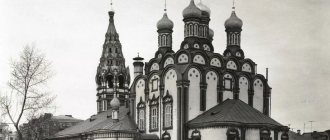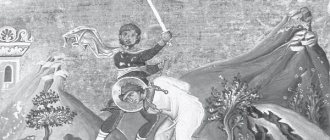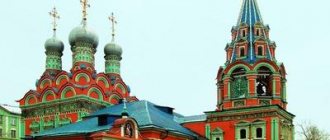Mir
Russia Moscow region village Novy Temple of St. Luke of Simferopol (Novy) Map is loading…
{"format":"leaflet","minzoom":false,"maxzoom":false,"limit":50,"offset":0,"link":"all","sort":[""], "order":[],"headers":"show","mainlabel":"","intro":"","outro":"","searchlabel":"\u2026 \u0441\u043b\u0435\ u0434\u0443\u044e\u0449\u0438\u0435 \u0440\u0435\u0437\u0443\u043b\u044c\u0442\u0430\u0442\u044b","default":"","import-annotation":false,"width ":"auto","height":"350px","centre":{"text":"","title":"""link":"""lat":55.808131000000003041350282728672027587890625,"lon": 37.29801499999999947476680972613394260406494140625,"icon":""},"title":"","label":"","icon":"","lines":[],"polygons":[],"circles":[ ],"rectangles":[],"copycoords":false,"static":false,"zoom":8,"defzoom":14,"layers":["OpenStreetMap"],"image layers":[] ,"overlays":[],"resizable":false,"fullscreen":true,"scrollwheelzoom":true,"cluster":false,"clustermaxzoom":9,"clusterzoomonclick":true,"clustermaxradius":80, "clusterspiderfy":true,"geojson":"","clicktarget":"","showtitle":true,"hidenamespace":false,"template":"","userparam":"","activeicon": "","pagelabel":false,"ajaxcoordproperty":"","ajaxquery":"","locations":[{"text":"\u003Cb\u003E\u003Ca href=\"/palomnik/%D0% A5%D1%80%D0%B0%D0%BC_%D1%81%D0%B2%D1%8F%D1%82%D0%B8%D1%82%D0%B5%D0%BB%D1%8F_% D0%9B%D1%83%D0%BA%D0%B8_%D0%A1%D0%B8%D0%BC%D1%84%D0%B5%D1%80%D0%BE%D0%BF%D0% BE%D0%BB%D1%8C%D1%81%D0%BA%D0%BE%D0%B3%D0%BE_(%D0%9D%D0%BE%D0%B2%D1%8B%D0%B9 )\» title=\»\u0425\u0440\u0430\u043c \u0441\u0432\u044f\u0442\u0438\u0442\u0435\u043b\u044f \u041b\u0443\u043a\u0438 \u0421\u043 8\u043c\u0444\ u0435\u0440\u043e\u043f\u043e\u043b\u044c\u0441\u043a\u043e\u0433\u043e (\u041d\u043e\u0432\u044b\u0439)\»\u003E\u0425\u0440\ u0430\u043c\u0441\ u0432\u044f\u0442\u0438\u0442\u0435\u043b\u044f \u041b\u0443\u043a\u0438 \u0421\u0438\u043c\u0444\u0435\u0440\u043e\u043f\u0 43e\u043b\u044c\u0441\u043a\ u043e\u0433\u043e (\u041d\u043e\u0432\u044b\u0439)\u003C/a\u003E\u003C/b\u003E\u003Chr /\u003E\u003Ca href=\"/palomnik/%D0%A1%D0% B2%D0%BE%D0%B9%D1%81%D1%82%D0%B2%D0%BE:%D0%90%D0%BD%D0%BD%D0%BE%D1%82%D0%B0 %D1%86%D0%B8%D1%8F\" title=\"\u0421\u0432\u043e\u0439\u0441\u0442\u0432\u043e:\u0410\u043d\u043d\u043e\u0442\u0430\u0446\ u0438\u044f\»\u003E\u0410\u043d\u043d\u043e\u0442\u0430\u0446\u0438\u044f\u003C/a\u003E: »'\u0425\u0440\u0430\u043c \u0441\u 0432\u044f\u0442 \u0438\u0442\u0435\u043b\u044f \u041b\u0443\u043a\u0438 \u0421\u0438\u043c\u0444\u0435\u0440\u043e\u043f\u043e\u043b\u044c\ u0441\u043a\u043e\u0433\u043e "" 446\u0438\u0430\u0442\u0438\ u0432\u0435 \u0433\u0435\u043d\u0435\u0440\u0430\u043b\u0430-\u043c\u0430\u0439\u043e\u0440\u0430 \u043c\u0435\u0434\u0438\u 0446\u0438\u043d\u0441\u043a \u043e\u0439 \u0441\u043b\u0443\u0436\u0431\u044b \u042e.\u0412. \u041d\u0435\u043c\u044b\u0442\u0438\u043d\u0430 \u0438 \u0440\u0430\u0431\u043e\u0442\u043d\u0438\u043a\u043e\u0432\u0433 \u043e\u0441\u043f\u0438\u0442 \u0430\u043b\u044f \u0438\u043c. \u0410.\u0410. \u0412\u0438\u0448\u043d\u0435\u0432\u0441\u043a\u043e\u0433\u043e. \u0425\u0440\u0430\u043c \u0440\u0430\u0441\u043f\u043e\u043b\u043e\u0436\u0435\u043d \u043d\u0430 \u0442\u0435\u0440\u0440 \u0438\u0442\u043e\u0440\u0438 \u0438 \u0433\u043e\u0441\u043f\u0438\u0442\u0430\u043b\u044f.","title":"\u0425\u0440\u0430\u043c \u0441\u0432\u044f\u0442\u0438 \u0442\u0435 \u043b\u044f \u041b\u0443\u043a\u0438 \u0421\u0438\u043c\u0444\u0435\u0440\u043e\u043f\u043e\u043b\u044c\u0441\u043a\u043e\ u0433\u043e (\u041d\u043e\ u0432\u044b\u0439)","link":"""lat":55.808131000000003041350282728672027587890625,"lon":37.298014999999999474766809726133942604064941 40625,"icon":""}],,"imageLayers":[]}
55.808149; 37.298069
Russia, Moscow region, Krasnogorsk urban district, Novy village, 1с1
Novy village, Moscow region
Russia
Church of St. Luke of Simferopol
built in 2002 on the initiative of Major General of the Medical Service Yu.V. Nemytin and hospital workers. A.A. Vishnevsky. The temple is located on the territory of the hospital.
History[edit]
June 28, 2002 in the 3rd Central Military Clinical Hospital located in the Krasnogorsk region. A.A. Vishnevsky, a solemn event took place - the founding of a church in honor of St. Luke (Voino-Yasenetsky), Archbishop of Crimea.
This leading military health care facility employs approximately 4,000 doctors, nurses and other military and civilian personnel. Every year at 3 Central Military Clinical Hospital named after. A.A. Vishnevsky is treating more than 21 thousand patients.
The clergy of the Krasnogorsk deanery district have been caring for the hospital for a long time: they communicate with employees, visit the wounded and sick, perform church sacraments at their requests, but the 3rd Central Military Hospital did not have its own church.
The initiative to build an Orthodox church on the territory of the hospital belonged to the then head of the hospital, Major General of the Medical Service Yuri Viktorovich Nemytin, who made a corresponding request to the hierarchy of the Russian Orthodox Church. The ceremony of founding the church was performed by the administrator of the Moscow diocese, His Eminence Metropolitan Juvenaly of Krutitsky and Kolomna, co-served by clergy of the Krasnogorsk deanery. The celebrations were also attended by the governor of the Moscow region Boris Vsevolodovich Gromov, the chairman of the Moscow regional Duma Valery Evgenievich Aksakov, the head of the Krasnogorsk district Boris Egorovich Rasskazov and other officials.
On December 12, 2005, priest Stakhy Zakhmarevich was appointed rector of the church still under construction in honor of St. Luke (Voino-Yasenetsky), Archbishop of Simferopol and Crimea.
On March 13, 2006, the dean of the churches of the Krasnogorsk district, Archpriest Konstantin Ostrovsky, co-served by the rector of the Church of St. Luke Voino-Yasenetsky, Priest Stakhiya Zakhmarevich, consecrated 5 crosses, which were installed on the domes of the new church that same day. The temple was built for about 5 years, but, of course, all these years the patients and hospital staff were not neglected by the clergy and other Orthodox believers. From the day of the founding of the church in honor of St. Luke on June 28, 2002, at the request of the Governor of the Moscow Region Boris Vsevolodovich Gromov and the blessing of His Eminence Metropolitan Juvenaly of Krutitsy and Kolomna, a chapel in honor of the holy great martyr and healer Panteleimon, assigned to the Znamenskaya Church in Krasnogorsk, operated in the hospital. Prayers for the sick were regularly served in the chapel, as well as the sacraments of baptism, confession and communion for the sick.
On June 11, 2007, on the day of remembrance of St. Luke (Voino-Yasenetsky), the parish of the church at the 3rd Central Military Clinical Hospital named after. A.A. Vishnevsky celebrated his patronal feast day for the first time. The rector of the temple, priest Stakhy Zakhmarevich, served a prayer service for the sick with the blessing of water and an akathist to St. Luke. A funeral litany was also served for all Orthodox soldiers and doctors who laid down their lives for the Faith and Fatherland. The first liturgy in the new church was celebrated on November 17, 2007.
The temple continues to be decorated; in 2010, for the patronal feast, a carved iconostasis and new icons were erected in icon cases. In May 2011, the rector of the Church of St. Luke, Priest Stakhy Zamarevich, turned to Metropolitan Yuvenaly of Krutitsy and Kolomna with a request to petition Metropolitan Lazar of Simferopol and Crimea for the transfer of a particle of the relics of St. Luke (Voino-Yasenetsky) from the Holy Trinity Convent of Simferopol to the temple of the saint Luke of Simferopol at the 3rd Central Military Clinical Hospital named after. A.A. Vishnevsky. Having received the archpastoral blessing, a small pilgrim group led by the rector of the parish went to Simferopol, and a particle of the relics of St. Luke was delivered to the temple. Immediately after this, in front of his holy relics, a prayer service for the sick was performed with an akathist to St. Luke, and everyone was able to venerate and venerate the relics of the saint: a bishop, ascetic, confessor of the great doctor and scientist.
On September 11, 2011, after the Divine Liturgy, the consecration of the bells took place.
October 18, 2012 The vicar of the Moscow diocese, His Eminence Archbishop Gregory of Mozhaisk, consecrated the temple.
Church in the name of St. Luke, Archbishop of Simferopol and Crimea, confessor
On Thursday, June 10 , the 40th day after Easter, the Church celebrates the Feast of the Ascension of the Lord God and our Savior Jesus Christ.
Happy holiday, brothers and sisters!
Troparion , tone 4:
Thou art ascended in glory, O Christ our God, having brought joy to the disciple, by the promise of the Holy Spirit, by the former blessing communicated to them, for Thou art the Son of God, the Savior of the world.
Kontakion , tone 6:
Having fulfilled your concern for us, and having united us on earth with the Heavenly One, You ascended in glory, Christ our God, in no way absent, but remaining persistent, and crying out to those who love You: I am with you me and no one else on you.
Zadostoynik , voice 5:
Magnify, my soul, Christ the Giver of Life who ascended from earth to heaven.
You, more than the mind and the word, the Mother of God, in the summer of the Flightless One, who ineffably gave birth, Vernia, we with one understanding magnify.
Prayer
Lord Jesus Christ, our God, who came down from the heavenly heights for our salvation and filled us with spiritual joy on the holy and bright days of Your Resurrection, and again after the completion of earthly things of Your ministry, ascend from us into heaven with glory and sit at the right hand of God and the Father! On this “clear and all-bright day of the Divine ascension into heaven” of Your “the earth celebrates and rejoices, the sky also rejoices at the Ascension of the Creator of creation today,” people glorify incessantly, visibly lost His nature that came and fell upon Thy frame, O Savior, was taken to earth and ascended to heaven, The angels rejoice, saying: He who came in glory is mighty in battle. Is this truly the King of Glory?! Grant to us who are weak, earthly still wise and carnal, to create unceasingly, Thy ascension into heaven is terrible, thinking and celebrating, carnal and worldly, putting aside cares and with the Apostles T Look at heaven now with all your heart and with all your thoughts, remembering what it is like in heaven There is grief for our residence, but here on earth we are just strangers and strangers, having departed from the house of the Father to a land far away from sin. For this reason, we earnestly ask You, by Your glorious Ascension, Lord, revive our conscience, even if there is nothing more necessary in the world, lead us out of the captivity of this sinful flesh and the world and create It is the wisdom of the heavens that makes us wise, not the wisdom of the earth, for we will not please ourselves and live, but we will serve You, the Lord and our God, and we will work, until we have renounced the bonds of the flesh and gone through the unrestrained ordeals of the air, and we will reach Your heavenly abodes, where we will At the right hand of Your Majesty, with the Archangels and Angels and all the saints, we will glorify Your All-Holy Name with the Beginning Your Father and the Most Holy One and Your Consubstantial and Life-Giving Spirit, now and ever and unto the ages of ages. Amen.
Greatness
We magnify You, Life-Giving Christ, and honor the Divine Ascension into Heaven with Your most pure Flesh.
Parish life[edit]
The temple spiritually nourishes patients and hospital staff, residents of nearby settlements.
During the fighting in hot spots, the parish actively cared for the wounded who were being treated in the hospital.
Collaboration with hospital management and staff helps in serving others. Doctors come to pray before surgery and send patients to church for confession and communion. Departments, operating rooms and other premises of the hospital are regularly consecrated.
Canonization
Luka died in 1961 at a fairly old age. This happened on All Saints' Day. They buried him in Simferopol near the Church of All Saints. After his death, people began to come to the burial, asked for help, and help came. In 1995, it was decided to canonize Vladyka Luke. Since then, people have been coming to his relics from all over the country for help and healing.
In 1996, the relics were transferred to the Holy Trinity Cathedral in Simferopol, where they remain to this day.
This is interesting! Luka remained a consultant at the Simferopol military hospital until his old age. He often performed operations and treated himself.
Why did the Holy Trinity Monastery begin to be named after the saint?
Nowadays, this relatively recently emerged monastery, the name of which is associated with the Church of the Holy Trinity, is increasingly called the monastery of St. Luke. First of all, because his relics have resided here since March 20, 1996, but also because the entire ministry of the saint during the last period of his life on the Crimean land is connected with the local church.
History of the monastery
Its location is the historical center of Simferopol, where local Greeks lived at the founding of the city. Even the Trinity Church, built in the 18th century, was called “Greek”. After all, it opened on the initiative of the national community, and besides, the services here were held in the sonorous language of Hellas.
"Greek Church"
Before the revolution, Trinity was one of many Orthodox churches in the city, but the mass closure of churches made it almost the only one. Indeed, although services were banned in 1933, less than a year later proactive parishioners, citizens of Greece, managed to achieve the return of the building, which they were already preparing to use as a children's boarding school.
However, fearing international complications, the authorities allowed services here. And after Simferopol lost its churches, first blgv. Alexander Nevsky, then Peter and Paul, the “Greek”, where believers of all nationalities already went, became a cathedral.
Service of St. Luke in the Cathedral
This is exactly how I found Trinity St. Luke, transferred to the Simferopol and Crimean See in 1946. The activity of the saint combined episcopal service with very intensive work as a doctor. He lectured to students and treated patients free of charge. But the Soviet “authorities” remembered the bishop as an extremely inconvenient “partner” of the authorities: upon arriving at the diocese, he, according to the Commissioner for Religious Affairs, did not even come to introduce himself.
Dissatisfaction was also caused by the fact that the saint resolved diocesan issues in accordance with the Charter, that is, by the authority of the bishop, without regard to those in power, sometimes even suppressing attempts by atheists to interfere in church life. It was almost impossible to frighten the saint, who had gone through more than one exile and been arrested more than once. In addition, he had to reckon with his authority as a doctor, who even had a State Prize for his developments.
The open preaching of Christ more than once brought the saint troubles: for example, he was forbidden to give lectures to doctors, since St. Luke came to them in a cassock, with the bishop's panagia. But his words were also heard at services in the Trinity Cathedral, although the authorities more than once hinted to the bishop to be “more careful” in speaking about the difficult relationship of believers with the authorities.
But the saint himself was firm and affirmed his flock:
“You will say that the government has harmed you Christians. And remember the ancient times, when the blood of Christians flowed in streams for our faith. This alone strengthens the Christian faith. It’s all from God.”
A kind of monument to that era - more than 700 words spoken by him, carefully collected into 12 volumes of typewritten text. 11 of them were sermons from the Crimean period.
Only occasionally did the saint burst out lamenting about the severity of the bishop’s burden in godless times. In one of the letters of 1958 to St. Luke says how difficult it was for him “to swim against the turbulent current of anti-religious propaganda and how much suffering it caused me and still causes.”
And, of course, the main thing was the performance of divine services. The saint served even when he completely lost his sight in 1955 - from memory, remembering all the prayers by heart.
11
June
1961
The great man of prayer, ascetic, true Doctor reposed in the Lord. It was the memory of All the Saints who shone in the Russian land - this righteous man went to them.
Spiritual fragrance
The honest, incorruptible remains of the saint of God were found during Great Lent in 1996, when the saint was still glorified only for local veneration. The entire city, among the inhabitants of which there were still many who personally knew the saint, then met their ruler; the procession slowly moved along the streets filled with people from the cemetery itself. Eyewitnesses of the event recall that the candles and flowers surrounding the coffin retained for a long time the unique fragrance emanating from the relics. An atmosphere of spiritual uplift and celebration reigned among the residents of Simferopol. So the saint returned to where he served and preached for a decade and a half. The day of the discovery of his miraculous remains turned out to be as symbolic as the time of his death: it was the memory of the holy martyrs, the Crimean saints, in whose host a new brother had now appeared.
How to get to the church?
Getting to the Church of St. Luke is not difficult; minibus No. 114 runs from the Simferopol bus station; you need to get off at the Lenin Square stop. From the airport you need to take bus No. 98 or trolleybus No. 9, the final one is the same.
You can also get there by car or on foot; from the center the route on the map looks like this:
Note to tourists
- Address: Odesskaya street, 12, Simferopol, Crimea, Russia.
- Coordinates: 44°56′57″N (44.949072), 34°6′15″E (34.104049).
- Telephone.
- Official website: https://svtluka.org.ua/
- Opening hours: from 7:30 to 18:00.
Today the temple of Simferopol, where the relics of St. Luke are kept, has become part of the convent; it is not considered by the diocese as a Cathedral, but is still always full of parishioners, and even tourists interested in the amazing personality of Voino-Yasenetsky! In conclusion, we suggest watching a short video about this shrine of Orthodoxy.
Liked? Share with your friends!








